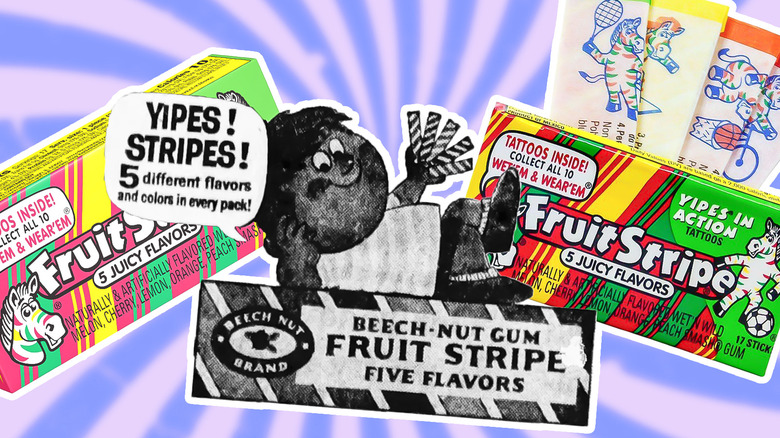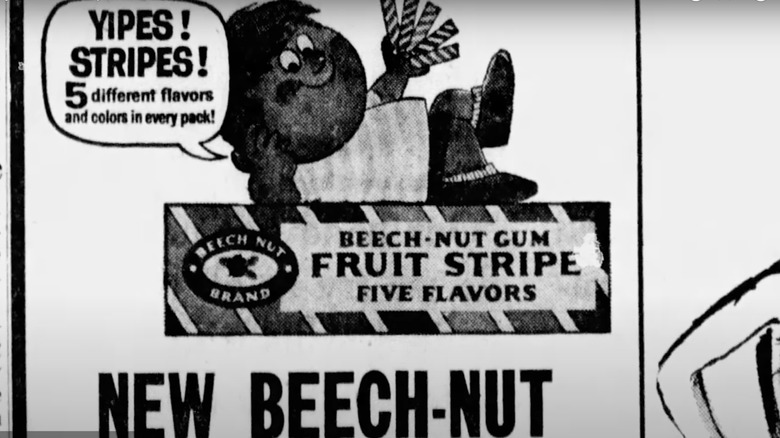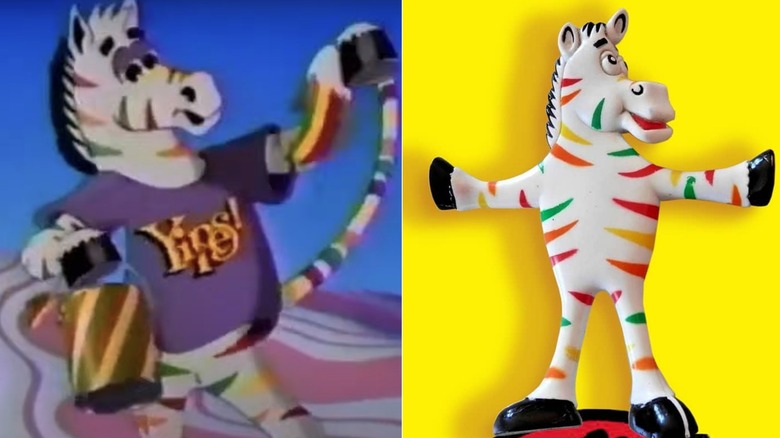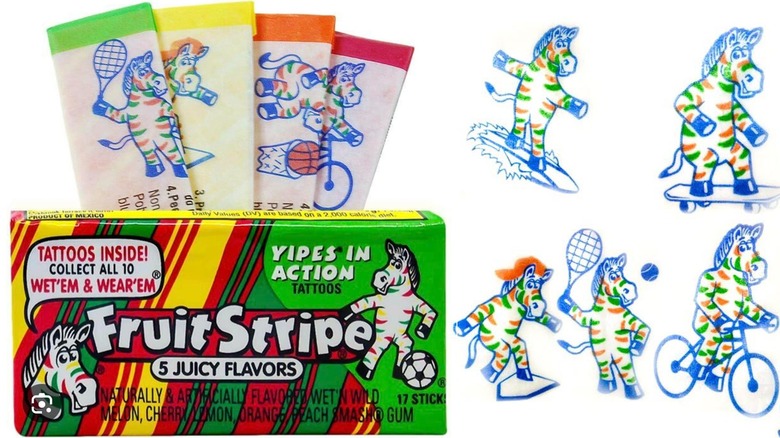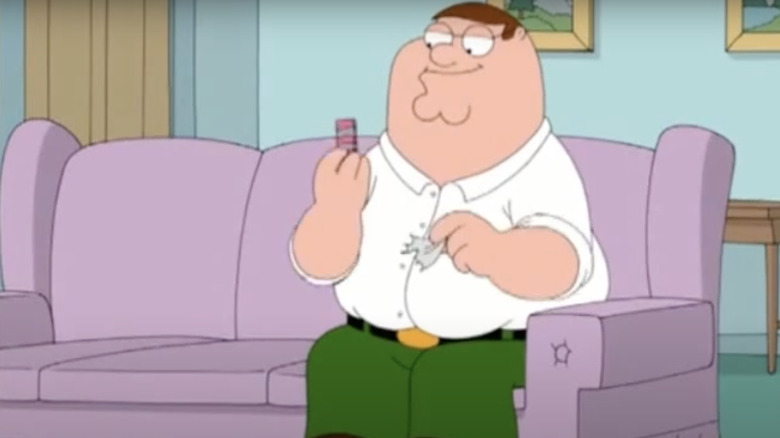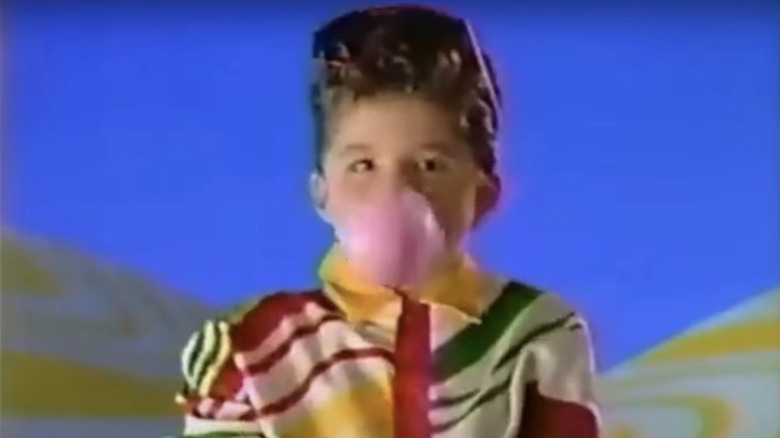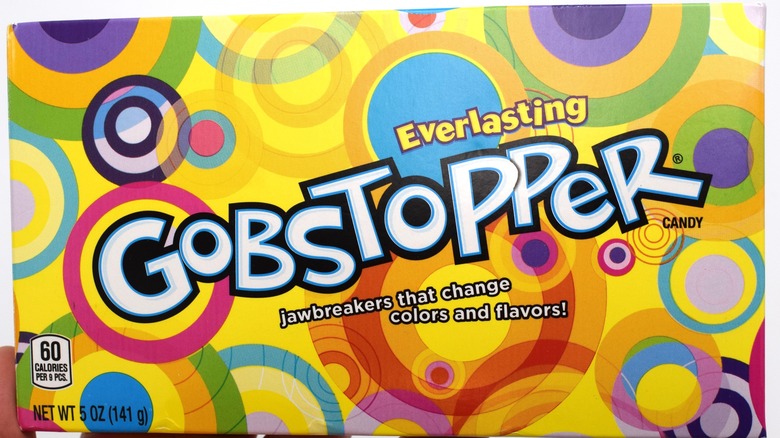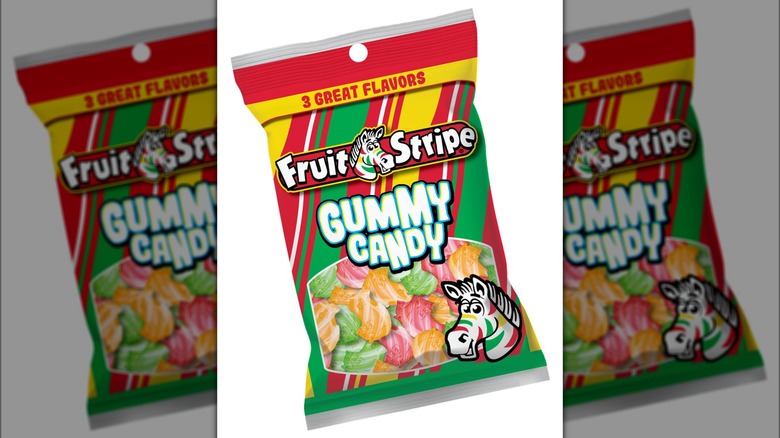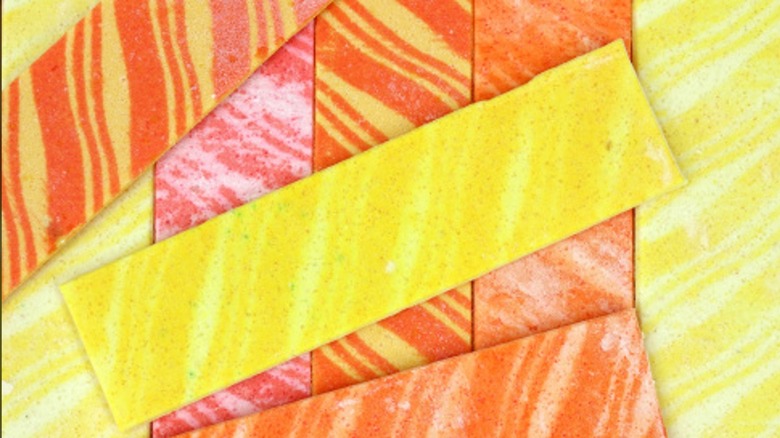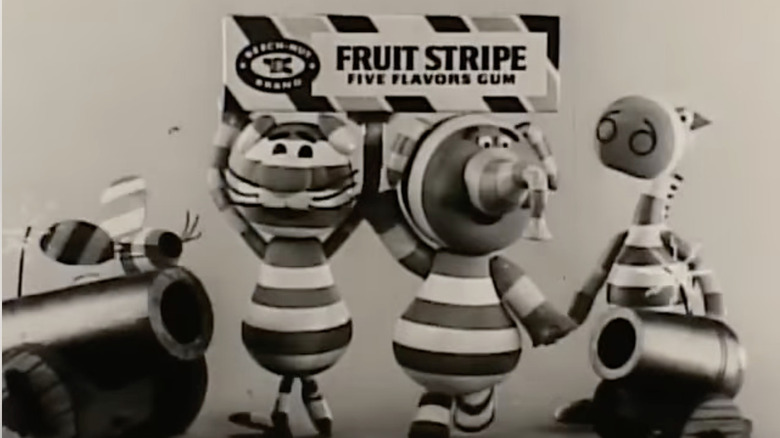The History Of The Discontinued Fruit Stripe Gum
Nostalgia is in — and if you identify as a Millennial, Gen X, or even a Baby Boomer, you might remember the classic Fruit Stripe Gum. As notable equally for its quick loss of flavor as its colorful zebra stripes and corresponding fruit flavors (Wet 'n Wild Melon, Cherry, Lemon, Orange, and Peach Smash), kids have always gone crazy for Fruit Stripe. In a mix of animation and live action, a classic commercial for the brand from the early 1990s showed a young, nerdy boy with a pocket protector transformed into a cool, hip kid with sunglasses by chewing the gum. Soon every kid wanted Fruit Stripe in their pocket!
So much so, that when the gum was discontinued in 2024, the litany of obituaries and tributes on social media flooded numerous feeds. @Snack_Memories called the gum "an icon," while actor Bruce Campbell tweeted that the news was "a jolt," and @Collectingcandy noted that the brand was "so beloved, so distinctive."
Sadly, although the gum has been discontinued after its over 50 years of production and distribution, its memory lives on. Read more about the rich history of this vibrant, quirky confection!
It was invented in the 1960s
Fruit Stripe Gum was invented in 1960 by James Parker, and soon after sold by the Beech-Nut Confection Division for five cents a pack. Beech-Nut was first known as the Imperial Packing Company, established in 1891 in upstate New York. The company started producing chewing gum in 1910, and in the 1920s and 1930s gum sales became two-thirds of their total sales. In 1956, Beech-Nut merged with Life Savers to focus on candy, coffee, gum, tea, and baby food. The company had grown into one of the biggest gum companies in America by the time Fruit Stripe came along.
The original Fruit Stripe was launched in five flavors: lime, lemon, cherry, orange, and mixed fruit, which was similar to the sister flavors in Life Savers. The packaging was colorful and vibrant on the packs and gum itself, and the commercials that hit the airwaves featured a variety of animated, striped characters — not a zebra, but instead, a tiger, horse, elephant, mouse, and even a young boy. Fruit Stripe was launched around the same time as Lemonheads, Jujyfruit, and Starburst, so eventually the flavors expanded to spearmint, peppermint, and grape to give more variety.
Yipes the Zebra was its famous mascot
While other animals have made appearances in Fruit Stripe commercials over the years, the most famous is Yipes the Zebra, who started appearing in commercials in the 1970s, and shortly after as a promotional stuffed animal giveaway. Christ Kallas, Associate Brand Manager at Ferrara Candy Shop, has said in interviews that it was natural Yipes prevailed as the main character, due to his stripes.
Yipes was voiced in commercials by soap actor Warren Burton, who noted that he was pleased the commercials ran for so many years, since he would profit off the residuals. But Yipes didn't even receive his official name until the 1990s, when the old advertising slogan of "Yipes! Stripes!" was used in updated commercials, and assigned to the zebra mascot.
Kallas went one step further, joking that Yipes has developed a full personality, both in the office and out. In an interview with Pop Icon, he said, "Yipes is a consummate professional with an eye for fashion. You can always count on him to have a styled mane and vintage threads," and he "is an outdoorsman who loves to be in nature when he is not dominating opponents in a game of one-on-one."
Yipes even became so notable that he was featured as a Jeopardy! clue in 2016!
Fruit Stripe had temporary tattoos and merch like stuffed animals
Another fun, if gimmicky, element that helped sell Fruit Stripe Gum to kids were the temporary "wet 'em and wear 'em" tattoos that were included in the wrapper of every pack. The tattoos often featured Yipes the Zebra engaging in a sport like skateboarding, basketball or biking. There were also items available for purchase such as coloring books, and bendy collectibles of Yipes the Zebra and "Fruit Stripe Gum Man."
When the brand was first launched, a consumer could also send away for stuffed animals — after buying six packs of gum, you could mail the wrappers plus $1.50 to receive a plushie in exchange. You might receive Orange Stripes the Mouse, Lemon Stripes the Elephant, Cherry Stripes the Horse, or Lime Stripes the Tiger. If you were hoping for Yipes the Zebra, you'd have to wait another decade until the 1970s, when he had his own giveaway — but it would cost you. The price was upped to $2.00 plus ten wrappers for the privilege of owning Yipes.
The gum was notorious for its quick loss of flavor
While Fruit Stripe Gum flavor was branded in commercials as "starts lively and stays lively," most consumers would report that the taste faded quickly. It was so well-known that the fruity flavor would dissipate after a few seconds, that a joke was created on "Family Guy" about it, with Peter Griffin saying, "You're more of a letdown than Fruit Stripe Gum" as he unwraps a stick and pops it in his mouth, showing his disappointment.
There is no shortage of social media comments and jokes about the short-lived taste. A Reddit user noted, "This gum tasted good for about two seconds," while another said, "The flavor was gone before I threw the wrapper away." @Snack_Memories tweeted, "They made Juicy Fruit look like an everlasting gobstopper."
Even the hosts of "The Today Show," reporting the end of Fruit Stripe's production, joked about the gum's reputation. Savannah Guthrie said on air, "The flavor lasted, like, 10 seconds ... but it was worth it."
Fruit Strip added bubble gum and other collaborations
As the years went on, Fruit Stripe realized that to keep up with trends, the company would need to innovate again. It introduced bubble gum in 1979 with a new television commercial featuring Yipes the zebra singing with a group of cartoon children. The bubble gum pack came in cherry, lemon, grape, and typical bubble gum flavor, eventually adding cotton candy and mixed fruit versions — all of which were striped, of course.
Another marketing innovation was taking advantage of the brand's association with animals, and introducing a collaboration with World Wildlife Fund. In the mid-1990s, Fruit Stripe announced they would donate five cents for every Jumbo Pack and Variety Multipack, raising about $100,000 for endangered animals. In 2015, there was even a co-hosted event called "Fruit Stripe Weekend" at the zoo in Greensboro, North Carolina to benefit the WWF. Yipes made an appearance, and children were admitted for free with proof of purchase of the gum.
Its parent brand owns other famous candies
The Fruit Stripe Gum parent company has changed many times, moving hands through many various owners over the decades. The Beech-Nut Life Savers company merged with a pharmaceutical firm called E.R. Squibb, becoming Squibb Beech-Nut in 1968. In 1981, Nabisco bought the candy components. In 2000 Fruit Stripe was sold to Hershey Foods in a deal with other candy brands for $135 million. But Fruit Stripe wasn't done moving yet — in 2003, the brand was sold to Farley & Sathers, where the owners also had stakes in Build-A-Bear and P.F. Chang's. Farley & Sathers also picked up Fruit Stripes' old competitors Jujy Fruits and Now and Later, as well as Chuckles and Super Bubble.
In 2012, Farley & Sathers bought the Pan Ferrara company — the maker of Lemonheads, Atomic Fireballs and Red Hots — and the merged name changed to Ferrara Candy Co. Ferrara is where Fruit Stripe ended its life, where other popular candies such as Fun Dip, Pixy Stix, Spree, Runts, and Gobstopper are still produced.
The company spun off with gummies in 2022
Ferrara Candy Co. was riding high on increased sales of Fruit Stripe Gum in 2021. Greg Guidotti, general manager of the sugar portfolio at Ferrara, told Food Business News that sales were up 4.5% from the previous year, and 13.2% on dollars per trip. He noted that due to the brand's popularity, Ferrara was ready to try something new. "We're bringing the fun of Fruit Stripe to another format that is more relevant to consumers today," Guidotti said at the National Association of Convenience Stores' 2021 NACS Show.
That new format was revealed in March 2022, when Ferrara Candy Co. launched a Fruit Stripe Gummy Candy. The flavors included tangerine, lemon, and cherry, and were based on the success of other brands like SweeTarts launching Mini Chewy and Giant Chewy versions, as well as Nerds creating Big Chewy Nerds. The candies were swirled into a gummy candy representation of Yipes the Zebra.
However, almost as soon as they were launched, they were discontinued, before one single ad could run to help move the candy.
The gum was discontinued in 2024
Sadly, even though sales seemed steady just a few years prior, Fruit Stripe Gum's production was discontinued in January 2024. A statement from Ferrara Candy Co. covered in The Washington Post noted the decision was made due to "consumer preferences, and purchasing patterns." Ferrara spokesman Brian Camen continued that the "difficult decision ... was not taken lightly."
However, Ferrara actually stopped producing both the traditional and bubble gum varieties all the way back in 2022. Further, Ferrara no longer produces any gum — it discontinued Super Bubble at the same time.
Eagle-eyed Reddit users started noticing that Fruit Stripe was disappearing from store shelves before the official press announcement. The Takeout reported that a user posted, "I was a bit confused when it began disappearing from my regular places I would buy it like Walgreens and Walmart."
It seems as if one big factor is that gum-chewing itself is declining in popularity. While 178 million Americans claimed to chew gum in 2011, only 157 million said the same in 2024, according to Statista.
The gum is still out there
If you're a Fruit Stripe Gum addict — don't despair! When Ferrara made its public statement about sunsetting the treat, it also made sure to add, "Consumers may still be able to find the product at select retailers nationwide." There are a few packs out there in the wild.
Where can you find Fruit Stripe today? There are still independent sellers: Check Ebay, where a 12-pack is going for just $10 (or a bigger investment of 12 packs for $179, plus $9.99 for shipping), or Poshmark, listing five single packs for $20. For those worrying about expiration dates, according to the International Chewing Gum Association, chewing gum is very stable, and "chewing gum is not required by law to be labeled with an expiration date ... the product will remain safe to chew."
If you're a real fan, you can even find the short-loved Fruit Stripe Gummy Candy on Amazon — for the low price of $4.59.
